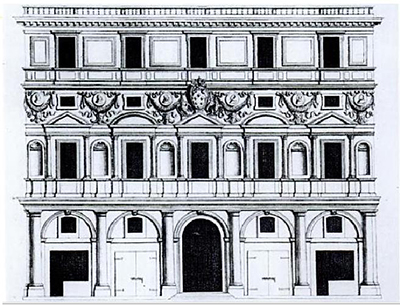Palazzo Branconio dell' Aquila is an artistic work of the Italian Renaissance artist Raphael. The work was commissioned by Giovan Battista Branconio dell' Aquila who was a papal advisor and goldsmith and it was executed by Raphael.
The artist designed this work between 1508 and 1520. The Palazzo Branconio dell' Aquila is a lost palace in rione Borgo. Raphael designed this building in his last years of life. In order to open up a square in front of Saint Peter’s Square, the palace had to be demolished in 1660 together with "Isola del Priorato" which was the adjoining building that had been named after Priory of the Knights of Rhodes. The name of the square that was established was Piazza Rusticucci. Another building that was located in the Borgo was the Palazzo Caprini (designed by Bramante). The palaces were torn down in the 17th century so as to make way for a colonnade. Since these beautiful palaces got destroyed, people only know about them through the 16th and 17th drawings and documentations.
The Branconio was more like Bramante’s Palazzo Caprini in terms of the architectural forms and the basic features but they differed in some important aspects like the treatment of columns. Both Giovan Battista Branconio and Raphael were early antiquaries. They had studied inscriptions, coins, ruins and physical evidence of the ancient past. Raphael strongly advocated for the preservation of ancient buildings and he believed there is the need of recording them through drawings. The design of the Palazzo Branconio dell' Aquila by Raphael clearly exhibits several significant innovations that had antique similarities in both the appearance and spirit.
One aspect that is noticeable about the Palazzo Branconio dell' Aquila by Raphael is the lack of rustication. This was a feature that was used traditionally on palace ground stories especially when fortification was necessary. Palazzo Branconio dell' Aquila made a break through the influence of Palazzo Caprini. Due to the absence of rustication, there were story-high engaged columns and they were of the Doric order. The manner in which Raphael used this story-high engaged columns that separated the arches made the internal structure of the building more expressive. Raphael came up with a mixture that was suitable to form a relief structure that was more elaborate, which made him to create some rich effects such as the ones he had admired from his antiquity.
Palazzo Branconio dell' Aquila shows Raphael's departure from the rational classicism shown by Bramante and the tendency of the heralds to invent architectural forms from novel ways. The building used niches above columns instead of supports over supports or openings over openings. The use of these niches brought about interplay between the convexity of the columns and the concavity of the niches. The building had staggering features illustrated by the staggered arrangement of the columns. To add to the staggering features were the arches of the ground story and the colonnettes.
Some parts of the Palazzo Branconio dell' Aquila were ambiguous because of being crowded together. In a way, Raphael’s building lost clarity and order, because of the architectural and ornamental crowding together. Another feature of Raphael’s combinations was the how the triangular and segmental pediments were alternated over the windows. This was an aspect he had used at the Palazzo Pandolfini, Florence.
The art forms of the building were well- enriched. Raphael used apsidal niches in between the windows. There was also used relief ornament autonomously not only in places it appeared to articulate the building but also over the surface. The images of the Palazzo Branconio dell' Aquila by Raphael took as whole assemblage that is representative of the interests and desires of the Giovan Battista Branconio dell' Aquila. The ornaments that were used abundantly gave this façade a very festive appearance. The building looked more like if was hung with some temporary decorations for a special occasion.




